
|   |

|   |
 e-mail: janakipatrik@gmail.com North Indian Kathak and American Tap: KA-TAP Photos courtesy: Janaki Patrik April 27, 2020 Tatkar and Tap. In my mind the combination was a no-brainer. By the time I hit my 20th anniversary as a Kathak dancer, I had thought about the similarity of Kathak tatkar and Tap dance steps for almost as many years. The opportunity to create a Kathak-Tap duet presented itself at Stephens College in Columbia, Missouri, where I was an artist-in-residence from January through March 1990. In conversations with Michael Simms, the ballet teacher in Stephens College's Dance Department, I learned that he had been a "hoofer" - a slang term for tap dancer. Michael somewhat reluctantly agreed to bring his tap shoes out of the back of his closet, but once we got into the studio, he enthusiastically joined in our "foot play". We decided to perform a duet to conclude my Kathak demonstration for the Dance Department's Spring concert. We chose an American standard composed in 1930, entitled "On the Sunny Side of the Street". Grab your coat and get your hat - Leave your worry on the doorstep - Just direct your feet - To the sunny side of the street. Can't you hear a pitter-pat? And that happy tune is your step - Life can be so sweet - On the sunny side of the street. - Composer: Jimmy McHugh, Lyricist: Dorothy Fields The bluesy rendition played and sung by the great American jazz trumpet player Louis Armstrong gave us just enough time to "strut our stuff" individually, punctuated by sections when we strolled arm-in-arm to the lighthearted lyrics. We ended the duet when Michael twirled me with a swing dance (1) move and threw his top hat into the audience. We had a ball! I don't have even one photo from that informal performance. The invention of camera-phones was still years in the future, and so was the current document-every-moment frame of mind. But these photos of couples swing-dancing give an idea of the exuberant informality of our choreography. 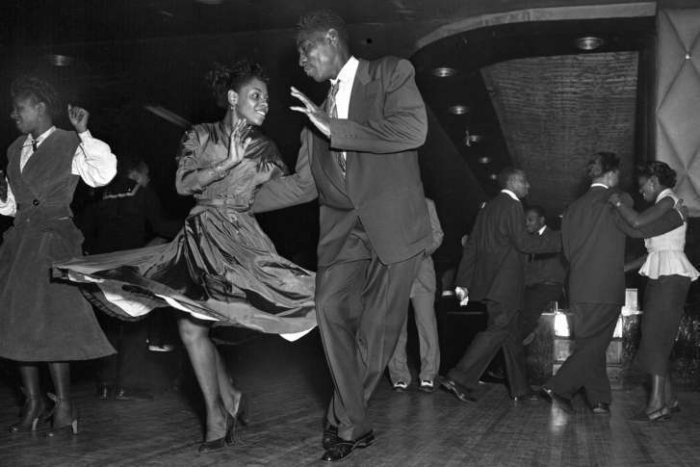 Swing dance @ The Apollo Theater 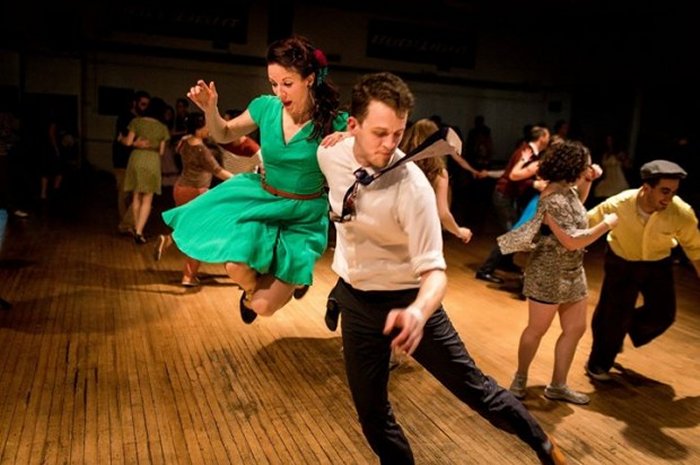 Swing dance @ The Nevermore These photos also bring to mind, that my choreographic "toolbox" includes a broad range of dance and music techniques which I have studied, plus visions in my mind's eye and sounds in my inner ear which originate in my life as an American. I don't edit them out just because I want to create choreography based on Kathak. Like many choreographers, I use moves and sounds and visions which my life experience has given me. For example, I don't follow the "no touching" convention in typical Indian dance partnering. Rather, I try to find ways within the tradition for appropriate touch-partnering. The little piece of fluff, which Michael Simms and I created, continued to tickle my subconscious. The concept was just waiting to be expanded into a full-blown production. That opportunity arose in 1994, when I was back in India on an American Institute of Indian Studies intensive Hindi language program, based for six weeks in Landour, Mussoorie and for another six weeks in Varanasi. I was surprised during an August monsoon downpour in Varanasi when a delivery boy from the local grocery store - which had the only public phone in the neighborhood - came sloshing through knee-high rain water to tell me that I had a call from America. The phone call was from Arun Aguiar, Vice-President of the New York Chapter of the Association of Indians in America. Arun asked whether I could put together my artistic team to perform "that Kathak-Tap program" I had mentioned to him. When I had left New York City in early June, Arun had not yet even proposed Ka-Tap to the AIA program committee. In the intervening two months, the committee had met and decided to present the Kathak-Tap production as a main-stage attraction for its annual Goddess Festival at the American Museum of Natural History. The only catch was that I wasn't returning to New York City until August 29th, and the program was on October 1st! Of course I said YES. Since the AIA and Natural History Museum's joint publicity mailing was going to press in just a few days, on the spur of the moment I named the production KA-TAP. I gave Arun Aguiar the name of tap dancer Neil Applebaum, whom I had already spoken with about the concept before I left for India. I also asked Arun to contact tabla player Samir Chatterjee. On the basis of that one short phone call, I returned to New York City, ready to go into an intensive rehearsal schedule to create a one-hour program with two new choreographies and two new collaborators -- in the space of 30 days. Neil suggested that Olivia Rosenkrantz, another rhythm tapper, join us. The KA-TAP music ensemble formed quickly. Samir Chatterjee was part of the publicity photo shoot with us three dancers (shown below), but he accepted a booking for October 1st, and as a replacement he suggested one of his senior students, tabla player Sajjad Chowdhry. Vocalist Sanghamitra Chatterjee and sitar player Ted Morano completed the Hindustani music ensemble. Neil and Olivia recruited jazz musicians with whom they were regularly performing - Frank Kimbrough on keyboard, Ben Allison on string bass and jazz vocalist Pat Tortorici. 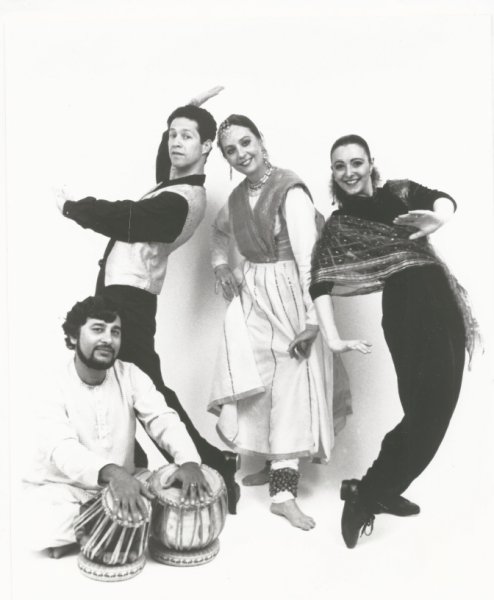 Janaki Patrik, Kathak dancer; Neil Applebaum and Olivia Rosenkrantz, Tap dancers; Samir Chattterjee, tabla player Photo: Frank Gimpaya My goal was to create a program with items displaying Kathak and Tap separately, plus opening and closing items which interwove the two techniques and highlighted their similarities. I would pair Sawal-jawab with the tradition of a Tap dance challenge ("duel"); tihai ending on sam, followed by a pause, paired with Tap's "3-and-a-break" convention; bol parhant with jazz "scatting", sthai-sthai-antara-sthai with the standard A-A-B-A 32-bar American song form of many of the so-called "Jazz Standards" (2). These were fundamental structures in our two distinct vocabularies, which would give form to our dance and music conversations. Introducing the very first performance of KA-TAP on October 1, 1994 at the American Museum, I had this to say about my vision for the program. Unfortunately the video image is somewhat distorted by the camcorder's faulty tracking system, but the audio recording is fine if you turn up the volume. 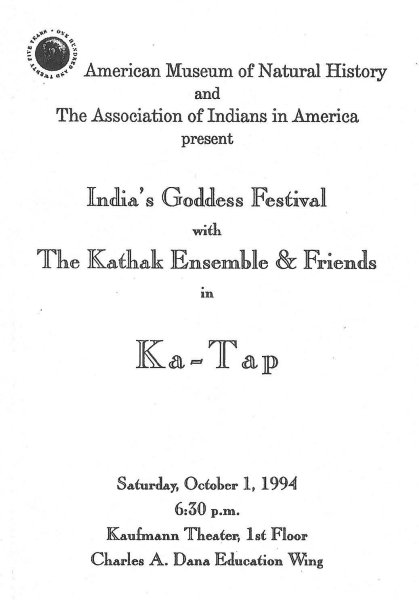 Cover of Oct 1, 1994 program notes To open the program, I chose the Kalavati tarana, composed and choreographed by my Guru, Pt. Birju Maharaj. The success of this item depended on Neil and Olivia having tap "chops", as technical expertise is called in jazz. The speed of their tapping had to match the speed of my tatkar. They met the challenge with crisp, lightning fast tapping, their metal taps matching the speed and sharp clarity of my metal ghungroos. I titled this item "Tap Tarana". A major decision was made when I chose to choreograph the Kathak-Tap interactions, rather than leave the structure open in a "jam session". The structures of many Kathak, Hindustani music, rhythm Tap and jazz items give space for improvisation. In my opinion, "improv" sections can either give scope for displays of technical prowess and creativity, or they can disintegrate into rambling, pointless repetitions of "filler" steps. In the case of Kathak, dancers can fall back on multiple chakkars (pirouettes) and fast Tig dha dig dig's; tap dancers can fall back on "time step" and other basic fast foot-patterns. I was not interested in presenting an informal "jam session" between the two styles. Thus, our challenge was to find one composition in each of the two styles - Kathak and Tap - from which we could create tightly-structured, dynamic choreographies. To close the program Neil, Olivia and I chose the jazz standard "Caravan", composed in 1936 by band leader-pianist-composer Duke Ellington and Juan Tizol. I had heard a great many of Ellington's iconic compositions, and I thought the melody and lyrics of "Caravan" were intriguingly off-center. "Caravan" was originally composed without lyrics, as heard in this 1937 recording. The version of "Caravan" upon which I chose to base the accompaniment of our finale had originally been played by Duke Ellington's orchestra with the lyrics sung by the great jazz vocalist Sarah Vaughan. If I parse the verses of "Caravan", it looks like this: Night and stars above that shine so bright The mystery of their fading light That shines upon our Caravan. Sleep upon my shoulder as we creep Across the sands so I may keep The memory of our Caravan. This is so exciting, you are so inviting Resting in my arms, as I thrill to your magic charms You beside me here beneath the blue My dream of love is coming true Within our desert Caravan. I asked Samir and Sanghamitra Chatterjee if they could provide a song in their tradition, which would complement the mood and meaning of Duke Ellington's "Caravan". Their suggestion was a perfect match - the Bengali song Kon se alor swapna niye..., originally composed by Sundhin Dasgupta and sung by Asha Bhosle in the 1969 film Prothom Kadam Phool. He seems to call me with a dream of that celestial light .... To the horizon of blue shadow Where the clouds have a golden touch of sunlight I will roam from country to country - Where dreams come true, Only if he receives me with a warm embrace. - Composition and lyrics by Sundhin Dasgupta, translated by Samir Chatterjee I suggested that the finale would "pack a wallop" if "Caravan" and Kon se alor... were sung simultaneously as the conclusion to the item. "Just try it", I said. Sanghamitra was doubtful but willing to try. She and our jazz vocalist Pat Tortorici forged ahead, and the entire ensemble was astonished by the beauty of this "mash-up". The finale began with Sanghamitra and Pat quietly singing the opening mash-up duet. The three dancers came on stage with traveling steps for 16 beats, with only the sound of their ghungroos and taps breaking the silence hanging in the air after the poetic reverie. Entrance of the music dramatized the Kathak-Tap challenge, which was punctuated in the middle by the tabla player and vocalist's conversation in bol parhant and scat. After a few short exchanges in the typical jugalbandi format (each exchange getting shorter and shorter), the three dancers came center-stage with the time-step, accompanied by the "Caravan" - Kon se alor duet. Short and sweet. A startling meeting of dance and music traditions from two great cultures. Footnotes: 1.Swing Dance & the Lindy Hop - The name swing came from the term 'swing feel', where the emphasis is on the off-beat or weaker pulse in the music. Swing dance is a group of dances that developed with the swing style of jazz music in the 1920s to 1940s, with the origins of each dance predating the popular "swing era". During the swing era, there were hundreds of styles of swing dancing, but those that have survived beyond that era include: Lindy Hop, Balboa, Collegiate Shag and Charleston. Today, the most well-known of these dances is the Lindy Hop, which derived loosely from popular steps danced in Harlem, NYC in the late 1920's. The dance was nicknamed the "Lindy Hop" in 1927 after aviator Charles Lindbergh made the first solo trans-Atlantic flight. A newspaper headline read "Lindy Hops The Atlantic". Condensed from Wikipedia 2. The so-called Great American Songbook refers to thousands of songs, also known as "American Standards", that are the most important and influential American popular songs from the early 20th century. Jazz musicians often use these songs as the basis for their playing. 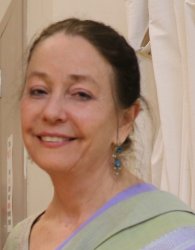 Trained in both classical Kathak dance (Pt. Birju Maharaj, beginning 1967) and Merce Cunningham modern dance technique (1971 to 1978), Janaki Patrik has choreographed thirty full-evening productions and numerous shorter works exploring an eclectic range of poetry, mythic storytelling and music. She is the Artistic Director and Founder (1978) of The Kathak Ensemble & Friends/CARAVAN, NYC. A dedicated teacher, Janaki has trained dancers to perform an extensive repertoire of classical Kathak, as well as her new choreography. Teaching and performing in inner-city schools through Urban Gateways/Chicago and Young Audiences/New York for forty years, Janaki has embodied the power of dance and music to communicate the interconnections of all cultures. Post your comments Please provide your name and email id when you use the Anonymous profile in the blog to post a comment. All appropriate comments posted with name & email id in the blog will also be featured in the site. |